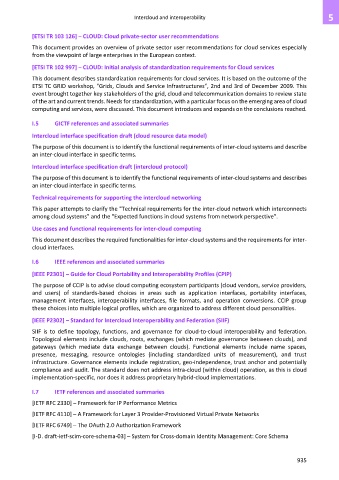Page 943 - Cloud computing: From paradigm to operation
P. 943
Intercloud and interoperability 5
[ETSI TR 103 126] – CLOUD: Cloud private-sector user recommendations
This document provides an overview of private sector user recommendations for cloud services especially
from the viewpoint of large enterprises in the European context.
[ETSI TR 102 997] – CLOUD: Initial analysis of standardization requirements for Cloud services
This document describes standardization requirements for cloud services. It is based on the outcome of the
ETSI TC GRID workshop, "Grids, Clouds and Service Infrastructures", 2nd and 3rd of December 2009. This
event brought together key stakeholders of the grid, cloud and telecommunication domains to review state
of the art and current trends. Needs for standardization, with a particular focus on the emerging area of cloud
computing and services, were discussed. This document introduces and expands on the conclusions reached.
I.5 GICTF references and associated summaries
Intercloud interface specification draft (cloud resource data model)
The purpose of this document is to identify the functional requirements of inter-cloud systems and describe
an inter-cloud interface in specific terms.
Intercloud interface specification draft (intercloud protocol)
The purpose of this document is to identify the functional requirements of inter-cloud systems and describes
an inter-cloud interface in specific terms.
Technical requirements for supporting the intercloud networking
This paper attempts to clarify the "Technical requirements for the inter-cloud network which interconnects
among cloud systems" and the "Expected functions in cloud systems from network perspective".
Use cases and functional requirements for inter-cloud computing
This document describes the required functionalities for inter-cloud systems and the requirements for inter-
cloud interfaces.
I.6 IEEE references and associated summaries
[IEEE P2301] – Guide for Cloud Portability and Interoperability Profiles (CPIP)
The purpose of CCIP is to advise cloud computing ecosystem participants (cloud vendors, service providers,
and users) of standards-based choices in areas such as application interfaces, portability interfaces,
management interfaces, interoperability interfaces, file formats, and operation conversions. CCIP group
these choices into multiple logical profiles, which are organized to address different cloud personalities.
[IEEE P2302] – Standard for Intercloud Interoperability and Federation (SIIF)
SIIF is to define topology, functions, and governance for cloud-to-cloud interoperability and federation.
Topological elements include clouds, roots, exchanges (which mediate governance between clouds), and
gateways (which mediate data exchange between clouds). Functional elements include name spaces,
presence, messaging, resource ontologies (including standardized units of measurement), and trust
infrastructure. Governance elements include registration, geo-independence, trust anchor and potentially
compliance and audit. The standard does not address intra-cloud (within cloud) operation, as this is cloud
implementation-specific, nor does it address proprietary hybrid-cloud implementations.
I.7 IETF references and associated summaries
[IETF RFC 2330] – Framework for IP Performance Metrics
[IETF RFC 4110] – A Framework for Layer 3 Provider-Provisioned Virtual Private Networks
[IETF RFC 6749] – The OAuth 2.0 Authorization Framework
[I-D. draft-ietf-scim-core-schema-03] – System for Cross-domain Identity Management: Core Schema
935

